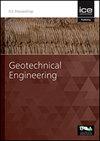Field test research and design of a new-type heliostat support structure in coarse gravel
IF 1.7
4区 工程技术
Q3 ENGINEERING, GEOLOGICAL
Proceedings of the Institution of Civil Engineers-Geotechnical Engineering
Pub Date : 2022-03-22
DOI:10.1680/jgeen.21.00147
引用次数: 0
Abstract
A solar power tower plant includes a solar tower and tens of thousands of heliostats, where the latter accounts for 40–50% of the total cost. To reduce heliostat costs, a new type of heliostat support structure that consists of a pre-stressed high-strength concrete (PHC) pipe pile and cast-in-place concrete is proposed. However, the performance and applicability of this structure are unknown. Thus, this paper reports full-scale field load testing of the proposed heliostat support structure on coarse gravel as subject to lateral loads or torsion-lateral combined loads. The results indicate that the lateral load amplifies the rotation under torque, and the proposed support structure for mirror arrays can provide sufficient rigidity to limit structural deformations within tolerable values under severe wind loading. Together with 3D modeling, the performance of the proposed heliostat support structure is thoroughly investigated to facilitate the development of modified prediction methods for its lateral and torsional load responses. A detailed design procedure is proposed for the new structure that considers foundation deformations, bearing capacity, and survival requirements. Finally, this study proves the applicability of the proposed heliostat support structure to improve the economic performance of solar power tower plants.一种新型粗砾石定日镜支架结构的现场试验研究与设计
塔式太阳能电站包括一个太阳能塔和数以万计的定日镜,其中定日镜占总成本的40-50%。为了降低定日镜的成本,提出了一种由预应力高强混凝土管桩和现浇混凝土组成的新型定日镜支撑结构。然而,这种结构的性能和适用性是未知的。因此,本文报道了所提出的定日镜支撑结构在粗砾石上受侧向载荷或扭转-侧向联合载荷的全尺寸现场载荷试验。结果表明,侧向载荷放大了转矩作用下的旋转,所提出的反射镜阵列支撑结构可以提供足够的刚度,在强风荷载下将结构变形限制在可容忍范围内。结合三维建模,深入研究了定日镜支撑结构的性能,以促进其横向和扭转载荷响应的改进预测方法的发展。提出了考虑基础变形、承载力和生存要求的新结构的详细设计程序。最后,验证了所提出的定日镜支撑结构对提高塔式太阳能电站经济性能的适用性。
本文章由计算机程序翻译,如有差异,请以英文原文为准。
求助全文
约1分钟内获得全文
求助全文
来源期刊
CiteScore
4.40
自引率
4.50%
发文量
68
审稿时长
3 months
期刊介绍:
Geotechnical Engineering provides a forum for the publication of high quality, topical and relevant technical papers covering all aspects of geotechnical research, design, construction and performance. The journal aims to be of interest to those civil, structural or geotechnical engineering practitioners wishing to develop a greater understanding of the influence of geotechnics on the built environment.

 求助内容:
求助内容: 应助结果提醒方式:
应助结果提醒方式:


